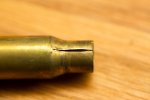Hi folks,
I'm working on developing my 308 handloads for a 16" AR10, and came across the following observation. I'm a bit perplexed as to the root case, and am hoping the community can shed some light.
I made two batches of handloads: same bullet, same powder load, two different brass, and tested on two different days using the same gun. Here's the results I got:
2019/9/22, 73F, 56% humidity
SMK 175gr
41.4gr of VV N140
Lapua factory new case
WLR primer
Avg vel: 2442 fps
Group: 0.400" @ 100yrds
2019/12/28, 42F, 87% humidity
SMK 175gr
41.4gr of VV N140
Lapua once fired brass
WLR primer
Avg vel: 2280 fps
Group: 1.180" @ 100yrds
2019/12/28, 42F, 87% humidity
SMK 175gr
41.4gr of VV N140
Winchester once fired brass
WLR primer
Avg vel: 2307 fps
Group: 1.081" @ 100yrds
As you can see, the grouping I've got on the second test is sub-optimal compare to my original load. The groups opened up by 2X+, and I'm perplexed as to what may be the contributing factor. During load development with SMK 175gr and VV N140 combo, I noticed as velocity lowers, my groups also opened up. The following numbers were obtained on 2019/9/22 in 73F temperature:
41.4 2400fps 0.400"
41.0 2388fps 0.728"
40.6 2344fps 1.384"
40.2 2312fps 1.161"
39.7 2261fps 1.320"
The groups I got on 12/28 in 42F temperature appears to match pretty well with the groups obtained with different powder load at the similar velocities.
So my question is, what is the most probable contributing factor to the decline in precision? Is it barrel harmonics due to a drop in velocity? If so, should a difference of 30F make as much as 150fps difference?
Or does the problem lie with the once fired brass I used in the second trial? They were resized to 308 chamber spec by a brass processing service. I also chamfered the case a bit aggressively with a Lyman case prep tool to aid with bullet seating, how big of a factor does that contribute to precision?
I highly appreciate any advice, thanks in advance!
I'm working on developing my 308 handloads for a 16" AR10, and came across the following observation. I'm a bit perplexed as to the root case, and am hoping the community can shed some light.
I made two batches of handloads: same bullet, same powder load, two different brass, and tested on two different days using the same gun. Here's the results I got:
2019/9/22, 73F, 56% humidity
SMK 175gr
41.4gr of VV N140
Lapua factory new case
WLR primer
Avg vel: 2442 fps
Group: 0.400" @ 100yrds
2019/12/28, 42F, 87% humidity
SMK 175gr
41.4gr of VV N140
Lapua once fired brass
WLR primer
Avg vel: 2280 fps
Group: 1.180" @ 100yrds
2019/12/28, 42F, 87% humidity
SMK 175gr
41.4gr of VV N140
Winchester once fired brass
WLR primer
Avg vel: 2307 fps
Group: 1.081" @ 100yrds
As you can see, the grouping I've got on the second test is sub-optimal compare to my original load. The groups opened up by 2X+, and I'm perplexed as to what may be the contributing factor. During load development with SMK 175gr and VV N140 combo, I noticed as velocity lowers, my groups also opened up. The following numbers were obtained on 2019/9/22 in 73F temperature:
41.4 2400fps 0.400"
41.0 2388fps 0.728"
40.6 2344fps 1.384"
40.2 2312fps 1.161"
39.7 2261fps 1.320"
The groups I got on 12/28 in 42F temperature appears to match pretty well with the groups obtained with different powder load at the similar velocities.
So my question is, what is the most probable contributing factor to the decline in precision? Is it barrel harmonics due to a drop in velocity? If so, should a difference of 30F make as much as 150fps difference?
Or does the problem lie with the once fired brass I used in the second trial? They were resized to 308 chamber spec by a brass processing service. I also chamfered the case a bit aggressively with a Lyman case prep tool to aid with bullet seating, how big of a factor does that contribute to precision?
I highly appreciate any advice, thanks in advance!



